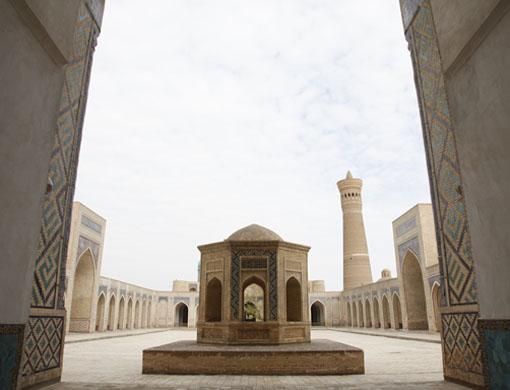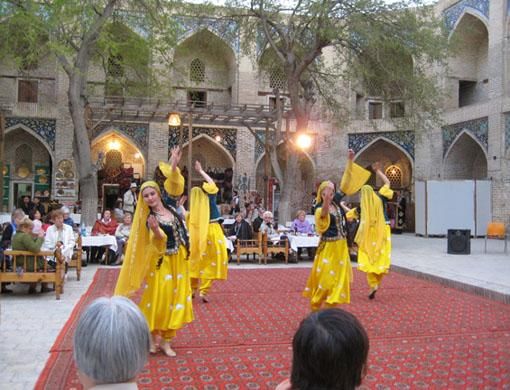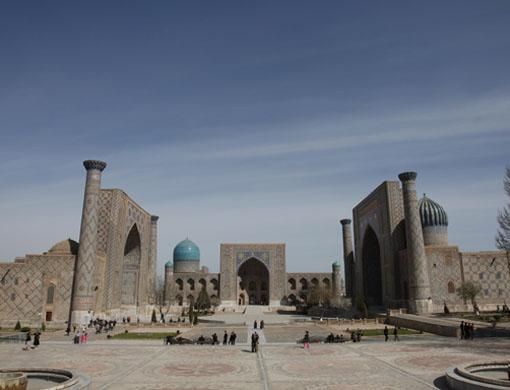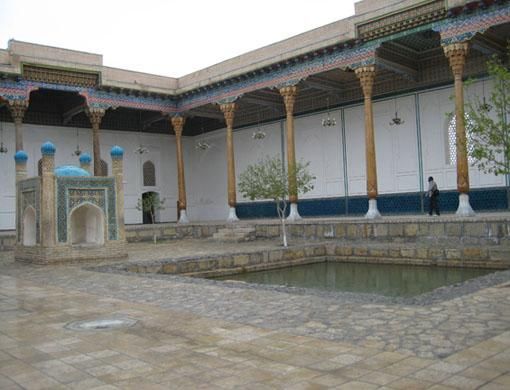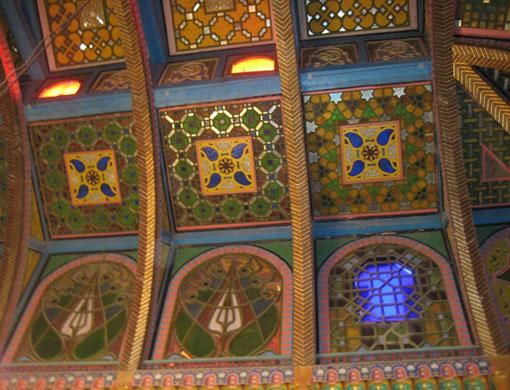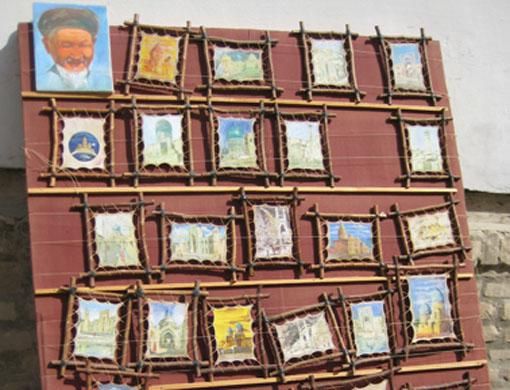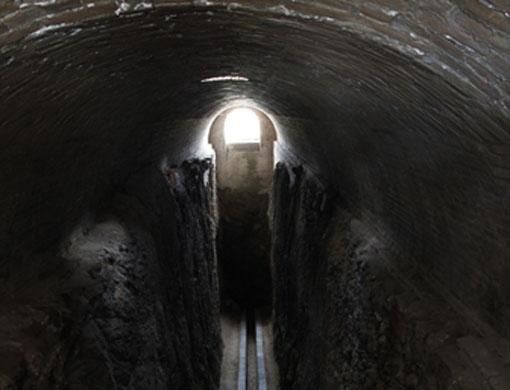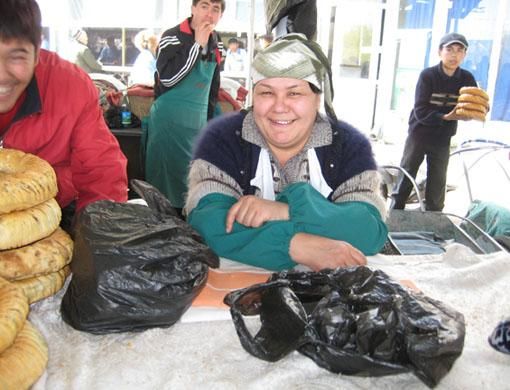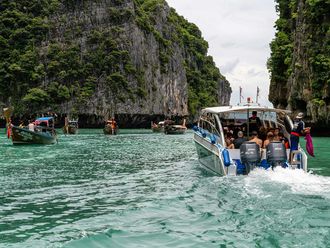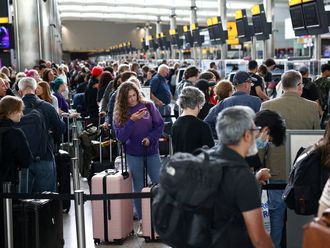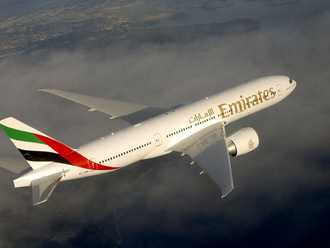“Namaste!'' There I was, enjoying a piece of warm, fresh bread, taking in the sounds and smells of the weekend milieu at Chorsu Bazaar in Tashkent, Uzbekistan, when the loud greeting surprised me.
“Namaste!'' I replied just as loudly, for I knew there was no other Indian there. I turned, trying to locate in the crowd the source of the greeting.
Friendly welcome
A young man, whom I had seen leaning over a trolley of meat just seconds ago, came running to me. “Hind?'' he asked. Yes, I smiled back. “Very good,'' he said, with a broad smile, as I was led away by our guide.
But this was definitely not my last encounter with the friendliness of the Uzbek people.
The next day, on our way to Samarkand, as I tried to convey to the shopkeeper that I wanted water with “no gas'', a woman walked up to me and asked: “India?'' Stepping off our bus, I had noticed her standing outside a shop nearby.
My reply in the affirmative conjured up a gold-toothed smile. The admiration in her eyes matched the brightness of her teeth. Once again, I was pleasantly surprised by the regard the Uzbek people had for my country.
Love for all
But I was mistaken. It wasn't just me or my country. I watched her share the same warmth with the others in our group also comprising Arabs, a Pakistani and Englishman.
Our photographer Dhanapalan was actually the Most Popular Person. While the people loved posing for his camera, they wanted him to pose with them too.
The conclusion: Uzbeks are, in general, a warm and welcoming lot. This is probably one of the main reasons I enjoyed my recent trip to the country so much.
We were a group of eight journalists and a photographer, making this journey, courtesy Uzbektourism and Uzbekistan Airways.
The trip was organised by the Dubai-based Planet Group, whose travel wing, Planet Travels & Tours, is the GSA for Uzbekistan Airways and Uzbektourism in the UAE and the rest of the Gulf Cooperation Council countries.
We had landed a couple of days earlier in the capital city of Tashkent and were now on our way to the historic city of Samarkand. But before we get to Samarkand, let me take you back a few days.
Warning signs
“What ‘-istan'? What's there to see in Uzbekistan?'' was the common question when I told my family and friends that I was to go on this trip.
“Oh, please don't go to Uzbekistan,'' piped in one. “What will you eat? I've heard they cook everything in yak butter and serve yak milk.''
Another said: “Be sure you get the necessary vaccinations before you go.'' This one was particularly scary, as just the week ago, a colleague had written an article about safety while travelling and, like all good journalists, had done her homework.
“It is recommended you take shots that protect you from hepatitis A and B and typhoid,'' she told me.
“Are you flying Uzbekistan Airways? Business class?'' queried another. “Carry some harness with you. Forget good seats, consider yourself lucky if you get stools.''
And then: “You're going to Uzbekistan? It's a beautiful place. Enjoy!''
This reaction, the only positive one I received, came from a soft-spoken journalist friend who had visited the country some years ago. “Don't worry,'' she said. “The place has everything you'll need.''
Yet I prepared. I made a survival kit of food (after all, it was just a week, I wouldn't die of hunger, I thought), got the immunisation done (the doctor wanted me to take a shot for diphtheria too) and as for the business class, I decided to take a chance.
Today, I feel sad that people have such flawed notions about Uzbekistan. This beautiful place is not only rich in history but also has great food, warm people and many wonders of nature.
Beautiful landscape
Sitting in an air-conditioned bus, I watched the landscape zoom by. The ride was often bumpy, till we reached the Gate of Temur, via which we would enter Samarkand.
The gate is named after Amir Temur, the ruler of the Temurid Empire. The landscape changed again — from flatlands to green mountains.
The Gate of Temur is a 150-metre-wide gorge, where the Sangzar, a mountain river, flows alongside the highway and the railroad.
The armies led by Alexander the Great, Genghis Khan and many Arab conquerors once negotiated these heights, where a cool wind blows throughout the day and throughout the year.
Capital pleasure
Our guide, Odilov Tulkin of Davr Tours, told us that Samarkand was once Temur's garden.
Known as Maracanda in ancient times, Samarkand served as the capital of Sogdiana, the residence of the Samanid dynasty, and then the capital city under ruler Amir Temur.
Today, it is the chief town of the province of the same name. Under the Samanids, the area became the rich seat of Arab civilisation, until it was pillaged by the forces of Genghis Khan in 1221. It was later revived by Temur.
Monumental times
The monuments of Samarkand are testimony to its wealth during Temur's reign. The Russians, who came later, retained the ancient mosques and madrasahs.
Let's start our tour of Samarkand with the Ulugbek Observatory, built by Temur's grandson, Mirzo Ulugbek, who, unlike his grandfather, believed the pen to be mightier than the sword.
The observatory bears testimony to the progress made by Islamic scientists in the field of astronomy as early as the 15th century.
Shahi-Zinda, an ensemble of mausoleums and funeral mosques, including those of several companions of the Prophet Mohammad (PBUH), was considered the principle sacred site of Samarkand in the 14th century.
Gur-Emir was the family mausoleum of the Temurids, which was reconstructed by the emir's son Shahruh and grandson Mirzo Ulugbek.
Elegantly complex
The piece de résistance in terms of Islamic architecture is the Registan Square, a complex of three madrasahs — the 15th-century Ulugbek Madrasah, the 17th-century Sher-Dor Madrasah and Tilla-Kari Madrasah, or the gold-covered madrasah, dating back to the 17th century.
Another place you shouldn't miss is the Bibi Khanum Mosque. At the centre of the complex stands a stone rest for a huge Quran.
Legend has it that any woman who goes around it thrice in a clockwise direction will have her wish come true (don't ask we tried it).
Bukhara-bound
However, it is not Samarkand alone which has a wealth of history.
Our next stop was Bukhara, where we went to savour some more magnificent architecture. During our drive to the place, the sky turned cloudy and I asked if it was about to rain. But Tulkin told me it hardly ever rained in this area.
As we approached Bukhara, he told us to watch out for the “shaggy hats'' on the top of minarets — stork nests, he explained.
In fairytales, the white bird is believed to be a harbinger of babies but in Uzbekistan, it is a symbol of firmness and stability.
Bukhara, though subjected to many invasions throughout history, has re-established itself every time.
The oldest part of the city is the citadel, the Ark, where archaeologists have made discoveries that date back to the 4th century BC.
The Chor Minar, with its four minarets, reminded me of the Charminar in Hyderabad, India.
Shrine to reverence
Another important place to visit on the way to Bukhara is Imam Bukhari's tomb and mosque, which is part of a shrine just outside the city.
Imam Bukhari, who is known best for his authoritative collection of the sayings of the Prophet Mohammad (PBUH), has also authored other works on the Prophet, including a large biographical dictionary of the transmitters mentioned in his Hadith collection.
We also visited the tomb of another important figure, Shaikh Bahauddin Nakshbandi, who was the spiritual tutor of Temur and founder of Sufism.
Revered by the people of the region as a saint and a protector of craftsmen, a pilgrimage to his grave is considered adequate substitute for Haj.
Fantastic four
Poi-Kalon, meaning “the pedestal of the great'', forms the base of the Kalon minaret. This is also the main ensemble in the city and consists of four monuments — the Kalon Mosque, the Mini-Arab Madrasah, the Kalon minaret and the
Amir Allimkhan Madrasah. Near this are the ancient gold and carpet markets.
The Sitorai Mokhi-Khosa Complex, built towards the end of the 19th century and the beginning of the 20th century, is one of the best palaces in Bukhara.
The hall is decorated with exquisite ornamental paintings and the walls are dotted with mirrors. The clouds which gathered earlier were already pouring when we went there and a dancing peacock added to the beauty of the place.
Another interesting place to visit is the Chashma Ayub, which dates back to the 12th century.
Legend has it that when Prophet Ayub was passing Bukhara, then a desert, he stabbed the ground with his stick, letting off a steady stream of clear healing water, which is said to flow even today.
Bukhara was also once famous for its caravan-sarais or inns, hauz or artificial pools, its food and the multidomed markets.
We had arrived at Bukhara in the evening, just in time to catch a cultural show at a centre that was once a madrasah.
Nowadays it showcases local talent in folk music, dance and handmade products such as embroidered dresses, jackets, silverware, handbags and musical instruments.
Culture calling
Uzbekistan is a country rich in culture and tradition. Music and dance is an essential part of life. We were not only lucky to see a couple of beautifully choreographed traditional dance shows in Tashkent and Bukhara but also got the chance to participate in one on our last night in Tashkent.
This again brings me to how friendly the people of the country are. Their gold teeth seem to be their only investment in life, though now the trend seems to be changing.
Prices of articles are pretty reasonable. You can even bargain and get an item at “your price''.
Watch your pocket
It's the money that's the problem. One journalist put it aptly (and I'm sure he wouldn't mind my borrowing his phrase): “If you are coming to Uzbekistan, make sure you have deep pockets.''
The currency runs in thousands and millions, so be prepared. But that's about the only glitch you'll face in the country.
Surprisingly, it had been raining the whole day in Bukhara. And as we approached the aircraft, it seemed to be bidding us a fond farewell.
Go there ... Samarkand, Bukhara ... From the UAE
We flew Uzbekistan Airways to Tashkent from Sharjah. The airline runs two days from Dubai and two days from Sharjah. Internal flights are available from Tashkent to Samarkand and Bukhara.
Fare from Dh2,580
Planet Travel & Tours is planning tailormade packages to Uzbekistan.
— For more information call Planet Travels & Tours on 04 2822199
Information
- Davr Tour, a local company, organised the group trip in Uzbekistan. Operating since 1999 under the Uzbekistan Airways, it organises standard and specialised tours for individuals and groups, and covers sites associated with history, religion, education, medicine, sport and even agriculture. For more information, log on to www.davrtour.com or write to davrtour@uzpak.uz
- Accomodation is decent, though there are no five star hotels in Uzbekistan (except in Tashkent). We stayed at the President Hotel in Samarkand and Bukhara Palace in Bukhara, both four star hotels.
- Food is not a problem, even for vegetarians. If you are looking for Indian vegetarian food, there are various places you can visit . An average meal will cost you around $15 (Dh55).
Not too different
Uzbekistan is the fifth-largest country in the area and the third most populated of the Commonwealth of Independent States (CIS) countries.
A landlocked country, bordered by Kazakhstan in the west and north, Kyrgyzstan and Tajikistan in the east and Afghanistan and Turkmenistan in the south, Uzbekistan gets little rain throughout the year, with temperatures rising up to 40°C in summer and dipping to 0°C in winter.
Sitting in an air-conditioned bus, I watched the landscape zoom by. The multistorey buildings of Tashkent had long ago given way to open fields and orchards.
As it was early spring, the land had just been tilled and, thus, looked bare. I saw fruit vendors selling produce from earlier crops on the roadside outside tiny villages. Come to think of it, it wasn't much different from my own country.


